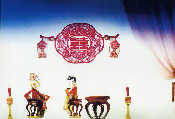Dating back as early as the Song Dynasty (960-1279), Chinese puppetry boasts a fine repertoire of styles and has entertained both the royal family and common public. Historical Chinese novels are usually adapted for puppet shows.
Having developed tremendously over the years, Chinese puppetry has combined artistic expressions with detailed handicrafts, traditional Chinese Opera movements and music, well-engineered mechanical puppet parts and western technology to tell stories. The art form generally falls in two groups: puppets shows and shadow plays.
 |
|
Puppet show
|
As all-time favorite toys of both children and adults, puppets come in many sizes, shapes and varieties and can be classified according to their structural characteristics.Zhangtoupuppets are manipulated by canes attached to a puppet's head, arms, legs and hands;tixianpuppets are string puppets,tiezhipuppets come with steel wires andbudaipuppets are hand puppets.
Puppet-show stage sets differ according to the type of puppets being used. String-puppet shows are mostly performed in the open air without a curtain to conceal the puppeteers and spectators can see the performances from three sides of the stage. Stages for glove-puppet shows are often examples of fine workmanship. Essentially, they are miniature palace courtyards with richly decorated buildings featuring carved rafters and golden roofs.
 |
|
Shadow puppet show
|
Shadow puppetry, a unique traditional art, is based on the penetration of light through a translucent screen or sheet where the shadows seen by audiences are silhouettes. Traditionally, the eight- to 12-inch puppets, scenery and props, such as furniture, pagodas, halls and plants are made of leather. There are three to five artists manipulating the puppets.
Shadow-puppet shows are one of the first traditional performance arts from China to catch on in the West. Mongol horsemen under the command of Genghis Khan and his successors swept across the vast Eurasian continent bringing shadow plays with them for entertainment purposes. Later on the plays entered Persia and spread to Turkey, Southeast Asia, France, England, Germany and other European countries.
The shadow play is an art form that combines theater, music, fine art and handicrafts. Puppet construction and the skills of puppeteers form an integral part of the traditional art. Manufacturing shadow puppets in particular is an elaborate process that begins with selecting a suitable hide and processing it, followed by carving and coloring. It is not surprising that some shadow puppets are found in world-famous art galleries.
 |
|
How to perform puppet show
|
The art of puppetry still flourishes to this day. A good puppeteer requires a lot of practice to perfect the craft. Puppeteers must be performers, storytellers, technicians or perhaps even artists. As they create a reality on stage to get audiences involved in the show, they must also perform technical movements with the puppets.
Since the 1950s, Chinese puppet-show troupes, with government support, have toured Europe, Asia, Latin America and Africa, and Chinese artists have created a large number of new puppet shows. In the early 1980s, the China Society of Shadow Plays and Puppetry Shows was founded, followed by the launch of a national week of puppet shows.
A sense of humor and love of fun mixed with talent contribute to the fun and entertainment that is the basis of puppet shows. Puppetry in China has been considered a performing art of immense appeal rather than casual amusement or child's play.
